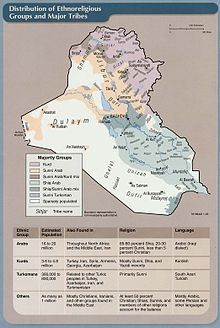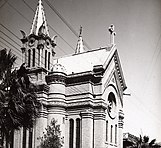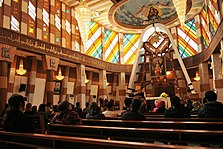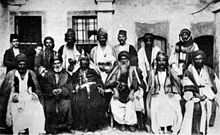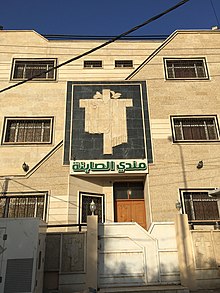
The Iraqi people are people originating from the country of Iraq.

Khanaqin is the central city of Khanaqin District in Diyala Governorate, Iraq, near the Iranian border (8 km) on the Alwand tributary of the Diyala River. The town is populated by Kurds who speak the Southern Kurdish dialect. Khanaqin is situated on the main road which Shia pilgrims use when visiting holy Islamic cities. The city is moreover rich in oil and the first Iraqi oil refinery and oil pipeline was built nearby in 1927. The main tribes of Khanaqin include Kalhor, Feyli, Zand, Malekshahi Suramiri, Arkavazi and Zangana.
Islam entered Iran with the Muslim conquest (637–651) and led to the end of the Sasanian Empire and the eventual decline of the Zoroastrian religion in Iran (Persia). Since its establishment after the 7th-century conquest, Islam has remained the state religion of Iran except for during a short period after the Mongol invasions and subsequent establishment of the Ilkhanate in the 13th century. Following the Muslim conquest, there was a slow but steady movement of the population toward Islam, despite notable resistance, with nobility and city-dwellers being the first to convert, and the peasantry and the dehqans, or land-owning magnates slower to do so. By the 10th century, the majority of Persians had become Muslims.

Iraqi Assyrians are an ethnic and linguistic minority group, indigenous to Upper Mesopotamia. Assyrians in Iraq are those Assyrians still residing in the country of Iraq, and those in the Assyrian diaspora who are of Iraqi-Assyrian heritage. They share a common history and ethnic identity, rooted in shared linguistic, cultural and religious traditions, with Assyrians in Iran, Assyrians in Turkey and Assyrians in Syria, as well as with the Assyrian diaspora. Assyrian diaspora in Detroit, Areas with large expat populations include Chicago and Sydney.
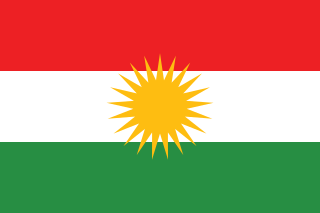
Kurdistan Region is an autonomous administrative entity within the Republic of Iraq. It comprises four Kurdish-majority divisions of Arab-majority Iraq: the Erbil Governorate, the Sulaymaniyah Governorate, the Duhok Governorate, and Halabja Governorate. The KRI is bordered by Iran to the east, by Turkey to the north, and by Syria to the west. It does not govern all of Iraqi Kurdistan, and lays claim to the disputed territories of northern Iraq; these territories have a predominantly non-Arab population and were subject to the Ba'athist Arabization campaigns throughout the late 20th century. Though the KRI's autonomy was realized in 1992, one year after Iraq's defeat in the Gulf War, these northern territories remain contested between the Kurdistan Regional Government and the Government of Iraq to the present day. In light of the dispute, the KRI's constitution declares the city of Kirkuk as the capital of Iraqi Kurdistan. However, the KRI does not control Kirkuk, and the Kurdistan Region Parliament is based in Erbil. In 2014, when the Syria-based Islamic State began their Northern Iraq offensive and invaded the country, the Iraqi Armed Forces retreated from most of the disputed territories. The KRI's Peshmerga then entered and took control of them for the duration of the War in Iraq (2013–2017). In October 2017, following the defeat of the Islamic State, the Iraqi Armed Forces attacked the Peshmerga and reasserted control over the disputed territories.
Minorities in Iraq include various ethnic and religious groups.

Iraqis are people who originate from the country of Iraq.
Yazdânism, or the Cult of Angels, is a pseudohistoric pre-Islamic religion with claimed ties relating to a Mithraic religion of the Kurds. The term was introduced and proposed by Kurdish and Belgian scholar Mehrdad Izady to represent what he considers the "original" religion of the Kurds.

Several different denominations and sects of Islam are practised within Syria, whom collectively, constitute approximately 87% of the population and form a majority in most of the districts of the country.

Asoristan was the name of the Sasanian province of Assyria and Babylonia from 226 to 637.

The Christians of Iraq are considered to be one of the oldest continuous Christian communities in the world.
For approximately a millennium, the Abrahamic religions have been predominant throughout all of the Middle East. The Abrahamic tradition itself and the three best-known Abrahamic religions originate from the Middle East: Judaism and Christianity emerged in the Levant in the 6th century BCE and the 1st century CE, respectively, while Islam emerged in Arabia in the 7th century CE.
Religion in Iran has been shaped by multiple religions and sects over the course of the country's history. Zoroastrianism was the main followed religion during the Achaemenid Empire, Parthian Empire, and Sasanian Empire. Another Iranian religion known as Manichaeanism was present in Iran during this period. Jewish and Christian communities thrived, especially in the territories of northwestern, western, and southern Iran—mainly Caucasian Albania, Asoristan, Persian Armenia, and Caucasian Iberia. A significant number of Iranian peoples also adhered to Buddhism in what was then eastern Iran, such as the regions of Bactria and Sogdia.
Religion in Syria refers to the range of religions practiced by the citizens of Syria. Historically, the region has been a mosaic of diverse faiths with a range of different sects within each of these religious communities.
According to the most recent government statistics, 97% of the population of Iraq was Muslim in 2010 ; the constitution states that Islam is the official religion of the country.

Erbil, also called Hawler, is the capital and most populated city in the Kurdistan Region of Iraq. The city is in the Erbil Governorate.
Islam is both the official and majority religion in the United Arab Emirates, professed by approximately 76% of the population.The Al Nahyan and Al Maktoum ruling families adhere to Sunni Islam of Maliki school of jurisprudence. Many followers Hanbali school of Sunni Islam are found in Sharjah, Umm al-Quwain, Ras al-Khaimah and Ajman. Their followers include the Al Qasimi ruling family. Other religions represented in the country including Christianity, Hinduism, Buddhism, Zoroastrians, Druze, Baha'i, Judaism, and Sikhism are practiced by non-nationals.

The main religions that exist or historically existed in Kurdistan are as follows: Sunni Islam, Shia Islam, Christianity, Zoroastrianism, Yarsanism, Yazidism, Alevism and Judaism. Overall today, Sunni Islam is the most adhered to religion in Kurdistan.

An independence referendum for the Kurdistan Region of Iraq was held on 25 September 2017, with preliminary results showing approximately 92.73 percent of votes cast in favour of independence. Despite reporting that the independence referendum would be non-binding, the autonomous Kurdistan Regional Government (KRG) characterised it as binding, although they claimed that an affirmative result would trigger the start of state building and negotiations with Iraq rather than an immediate declaration of independence of Kurdistan. The referendum's legality was rejected by the federal government of Iraq.

Sunni Islam in Iraq is the second-largest sect of Islam in Iraq after Shia Islam. The majority of Iraqi Sunni Muslims are Arabs. Iraqi Sunni Muslims mainly inhabit the northern half of Iraq. Sunni Arabs primarily inhabit the Sunni Triangle, Upper Mesopotamia and the desert areas, such as Al-Anbar Governorate in the Arabian Desert and Syrian Desert. The Sunni Kurds inhabit the mountainous Iraqi Kurdistan region.

